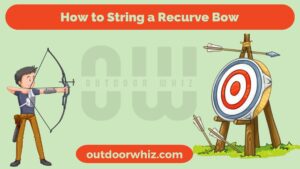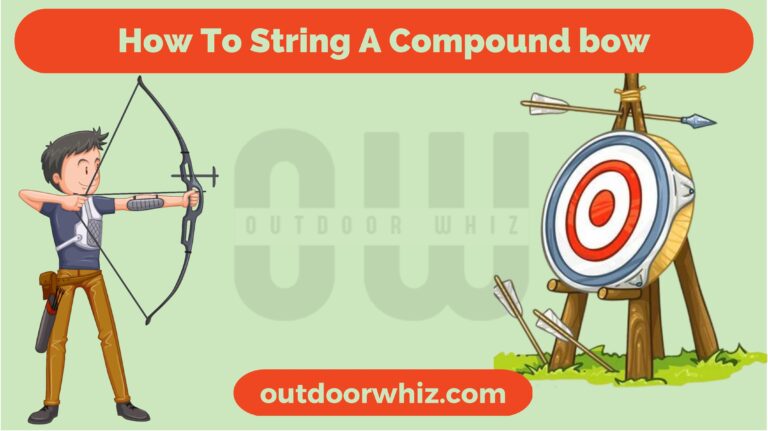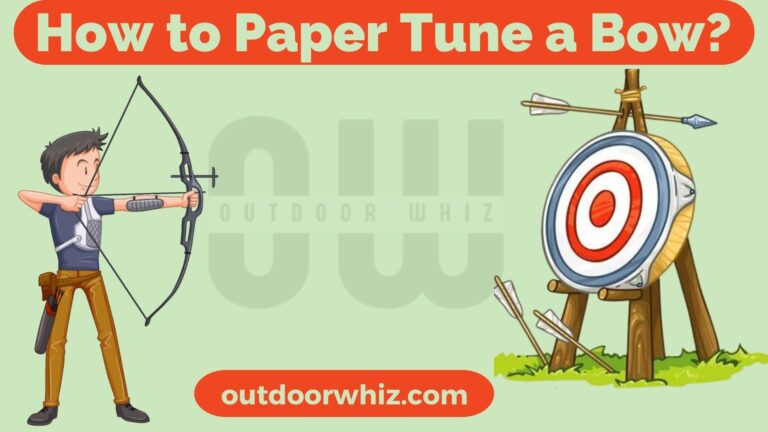Every archer wants to master the bow and arrow execution and its maintenance. However, sometimes issue like setting the string on recurve bow can halt the progress.
If you are one of those archers learning new tricks and tips and wondering how to string a recurve bow, this article covers all the aspects you are searching for.

Read the complete article and know how to string your recurve bow easily.
Page Contents
How To String A Recurve Bow?
Stringing the recurve bow with or without string is the main problem that many archers face. If you are one of them, you must be in severe tension about how you can do this. Stringing the bow requires expert skills that you can get by practicing it.
Knowing the skill of stringing your recurve bow is the first thing you need to learn after becoming an archer. If you are an archer or bowhunter, stringing and unstringing your bow are the skills that you must master over. Stringing your bow needs a specific tool called a bow stringer; if you do not have any string, you have to do this without any string.
Follow this how to string a recurve bow step-through guide for more understanding of the process.
How To String A Recurve Bow Without Stringer?
It is possible to string your bow without a string by holding it with your hand. One person must help string your bow and hold the ends for you. Before stringing the bow, remove all the accessories from it. Trigger guards, quivers; arrow rests are included in its accessories that have to remove. They will only get in the way of bowstringing, which will be annoying.
You must remember that stringing the bow is possible, but it is not a simple task; it requires patience. Wearing an armed guard will protect you from any harm. If you want to learn how to string a bow without a stringer, follow these two methods:
Method 1: String The Bow By Foot Bracing Method
The first step to string your bow is the foot bracing method which is one of the most accurate methods. In this method, you must have the excellent arm strength.
Plant one foot on any one side of the recurve bow. Hold the top end of the bow with one hand, and before placing it on your shoulder, pull it back toward yourself.
If you do not have strong arms, this method might be challenging for you because it is one of the most challenging methods. Skilled and experienced archers can only do it.
Method 2: Stringing The Bow By Step-Through Method
In this method, you have to tie the handle of the bow’s grip to one end of the string and pull the string one or two inches below the bottom limb. Now you have to tie the object almost four inches from the limb to the second end of the string.
Place one end of the string on one foot and the second on the other. Now tighten the string by pulling it upward before it returns to the ground.
These are the best ways to string a bow without a stringer. Following these methods, you can quickly learn how to string a recurve bow without a stringer.
How to String A Recurve Bow With A Stringer?
You can do it with little skill and effort if you want to learn how to string a recurve bow with a stringer. Before starting the bowstringing, you must ensure that the string you are using is more robust and of good quality. There are three methods by which you can do this:
Method 1: Remove Or Loosen The Previous String
When learning how to string a recurve bow using a stringer, the first thing is little patience. Then, you need to lose and remove the string from the bow. The string you remove must be loose enough to put your hands around it. You have to remove the ends of the strings from the loops. Pull it out from the bowstring to attach a new one.
Method 2: Attach The New String
After removing the last string, you must attach a new string with a bow. Take an object with a flat edge or a piece of paper; you will need this. For each end of the bow, you will need almost 5-inch loose string. Now you have to pull back both ends of the string until they both meet at the other side of the node.
Method 3: Tighten The String
You have to tighten the string after passing it through the hole. On the nocking point, place one end of the string, and then you have to wrap the limb with a string until it becomes tight enough not to move in any situation. Finally, try the bow to know whether the string has tightened and is working accurately.
It is the complete method that will help you to string a bow with a string. If you have a string, follow the instructions; if you do not, then you have to follow the instructions related to stringing the bow without a stringer.
How to String A Bow By Hand?
Stringing a bow by using a hand is very simple and easy. If you are stringing your bow, I’ll say to get an appropriate string suitable for your bow. The nylon bow is very cheap and best for bow security. A good stringer is necessary because many people get hit in their eye while stringing their recurve bow, so you must be careful about that.
As you know that the string and stringer both have two loops. Both have one bigger and one smaller loop. You will have to use a giant loop of stringer and string over the top limb. Here is the complete procedure of recurve bow stringer to string a bow by hand:
- Place the larger loop of the stringer over the limb, and then slide it down until it can no longer slide, stop there.
- Now use the larger loop of the string to pass through the larger loop of the stringer that you recently passed over the limb.
- Now place the larger loop of the string on the top of the limb and then slide it down just like you did before. Slide it down until it cannot slide more; you must stop there.
- Now use the small loop of the string and pass it over the other limb of the bow. Here, you must ensure that the loops you are fixing over the limbs must be tightly and accurately fitted.
- Now take the smaller loop of the stringer, pass it over the below limb of the bow, and then slide it down.
- Hold the bow in one hand, lower it toward the ground, and place both your feet on the stringer. Now start pulling the bow in an upward direction and slide your one hand on the top loop of the string.
- That is the final process, go into your yard and shoot the targets using this bow to check its results.
If you were wondering how to string a recurve bow by hand, then by using this complete process, you can change the string of your bow by hand.
How To Unstring A Recurve Bow?
When anyone strung their bows, recurve bows remained in strain. They have the energy that archers use to shoot their targets with power. This energy in strings makes them dangerous to string and unstring, so there are a lot of cheap stringers that are super easy to unstring and also significantly less dangerous if you do the process with patience.
The process of how to use a bow stringer to unstring and restring is as follows:
- First, you must buy a bow stringer; these strings are made of leather pockets at both ends. Unstringing the bow with the hand can be a little harmful to your hands, so first of all, cover your hands and continue the process.
- Place the larger loop of the stringer that looks like a larger pocket over the below limb of the bow and ensure that it fits properly.
- Take the smaller loop of the stringer and pass it over the top limb of the stringer, and make sure that it also fits accurately.
- Hold the bow in your hands in the horizontal direction, lower it to the ground, and place your feet on the stringer.
- Now, pull the bow upward and use your hands to pull the limbs up. Continue this process; you will see the loops of the strings over the limbs will get tension.
- Unhook the upper loop of the string from the above limb and then slowly unhook the string loop from the lower limb.
- Hold the bow until the string becomes slack; after that, you have to release the bow, and the limbs will come to their resting position.
How To Restring A Recurve Bow?
Here is the complete procedure to do that:
- Take your recurve bow and stringer of leather stuff. Place the larger loop of the stringer to the below limb of the bow.
- And then a smaller loop of stringer over the top limb of the bow.
- Hold your bow horizontally, and lower it to the ground. Place your feet on the stringer and pull your bow upward.
- Now the bow’s limbs will stretch and move slightly in a lower direction from the corners. It is the time when you have to restring the bow.
- Hold the bow in one hand, and by using the other hand, place the larger loop of the string over the bow’s top limb and then a smaller loop over the below limb.
- After doing this, release the stringer and hold the bow in your hands, and that’s it. You have done stringing your bow. Slowly remove the larger and smaller limbs of the stringer from the bow and save it for after-use.
Recurve bow stringing is not challenging if you follow the instructions carefully.
How To String A Traditional Bow?
If you have a traditional recurve bow, then there is no need to worry about that. This method is only suitable for the traditional recurve bows:
- First of all, find the top and bottom loops of the string.
- Place the larger loop of the string over the top grove of the bow.
- Now place the smaller loop of the string over the bow’s lower limb.
- Now, carefully you have to place the smaller limb of the stringer over the top limb of the bow and the more giant over the lower limb.
- Hold the bow in your hand, place your feet on the stringer, and pull the bow up to slide the top loop into the string grove.
- Now slowly and smoothly release the stringer after ensuring the string has fitted in its place.
- You can do this process if you want to string your recurve bow safely and accurately.
How To String Walk A Recurve Bow?
String walking is simple; you only need a technique to do this. In this method, place your palm on the tip of the bow and then grab the string. Place its loops over the bow’s limbs, then hold the bow in your right hand and place the left hand on the back of the bow. Pull the bow with your right hand and push using your left hand. Use your left thumb and fingers to slide the loops of the string over the bow.
How To String A Bear Recurve Bow?
If you are finding a method about how to string a bear grizzly recurve bow, it is not different from other recurve bows. Bear recurve bows are famous among traditional hunters. Their string method is straightforward. You can use a stringer for the purpose if you want assistance. If you want to go the traditional way, stringing by hand or without a stringer is also possible.
How To String A Samick Sage Recurve Bow?
Samick Sage Recurve bow is a highly practical bow for beginners. However, it does need little attention when stringing due to its long arms. Stringing the Samick Sage bow is best when using a stringer, as it helps you quickly adjust the strings according to the required level.
How To String A Mongolian Recurve Bow?
String a Mongolian recurve bow is best when done with the step-through method. Attach one end of the string to the bow and then take the support from the thigh to rest securely. Now bringing the other end of the string to the bow end and attaching both will do the work. Check after setting the string whether it is perfect, and voila.
How To String A Hoyt Recurve Bow?
You can string the bow by standing on your feet. In typical methods, you must place the stringer’s loops into the bow’s limbs. Usually, archers nocked one end using one leg and braced the bow by pulling the limb forward. In this method, you need strength and power; otherwise, you will damage your bow. It is crucial to string your bow with any skilled archer who knows how to string a bow.
How To String A Pse Recurve Bow?
Stringing the all-type bows is almost identical, but little effort and techniques you need. You can string your bow by using the Pull-Pull method and Seated Method. There are many historical methods through which you can string your bow, but skill and technique are required. Don’t rush to string your bow; otherwise, your bow will get damaged.






